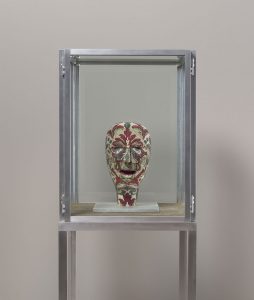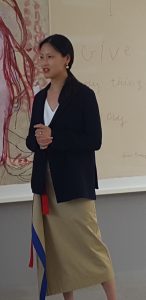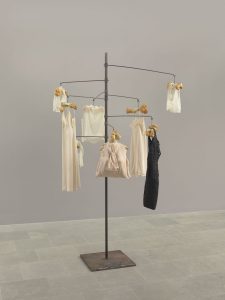The art of Louise Bourgeois does not lie. The unyieldingly honest new exhibit of the celebrated French-born artist’s work at Potomac’s Glenstone Museum is a decades-long confessional in bronze, plaster, marble, rubber, glass, fabric and needlepoint.
“Louise Bourgeois: To Unravel a Torment,” which opened May 10, spans the late artist’s extensive career. From the charming and folkloric “Personages” to the “I Give Everything Away” panels, the exhibit, co-curated by Emily Rales and Bourgeois’ long-time assistant Jerry Gorovoy, includes some of the artist’s most coveted works.
The collection of about 30 mixed-media masterpieces from the personal collection of Glenstone proprietors Emily and Mitchell Rales is as multidimensional as the artist herself.

Many know Bourgeois as a doyenne of modern art. Fewer know her as a prolific, habitual artist who created with gusto, and sometimes ire, well into her ninth decade. To visit the show at Glenstone is to peer into the many lives of Bourgeois, all of which draw heavily upon a complicated childhood.
One docent said, “To Bourgeois, making art was as fundamental as breathing or sleeping.” Another gallery guide said, “She just had to get it out. Then, she’d give it away, presumably to make room for more. And more.”
Visitors are encouraged to tap into the gray-uniformed docents stationed throughout the gallery. They are among many first-class features at Glenstone. They bank a wealth of Bourgeois backstories, bringing visitors closer to the art than a typical museum experience.

The show is hung chronologically. Visitors are asked to begin to the left of the main entrance; a change from exhibits past, and one that may seem backwards to some. Don’t look for meaning, said Emily Rales, during a recent press tour. “The decision [to start in that direction] was purely logistical,” pointing to the wood floors. Bourgeois’ early “Personages” sculptures — which stand guard at the beginning of the exhibit — require a wood floor for proper fastening. Not all the floors are wood; some are cement. “You can’t drill holes in cement as easily as wood,” Rales said.
Pieces live comfortably in each room of the gallery, so one does not upstage another. This Glenstone-esque technique is one way the Rales deliver a “relaxed, contemplative” experience for visitors. “No hurry, no crowding and no admission fee” are hallmarks of this understated, some say “secret,” museum on former foxhunting farmland in hilly Potomac.
Pastoral as the secluded museum is, the Bourgeois exhibit is not quiet. Some rooms nearly scream. Severed limb castings and anatomical-based works are a central theme and are for adult eyes only. Glenstone’s 12-year-old age restriction protects the innocent.

Bourgeois’ body of work has many chapters. Rales noted that that artist’s introduction of a new material or subject matter symbolizes a transitional life event.
Pieces like “Avenza Revisited II” (1968-69) loom large next to “The Quartered One” (1964-65). Vastly different, they are connected by the curiosity they command. Touring front, back and sides of each piece is recommended. What looks heavy might be hollow. What invites may also repel.
“The Destruction of the Father” (1974) demands a space all its own, while “Legs” (1986) goes almost unnoticed.” Le Défi IV” (1994), a collection of bottles on a painted wooden cart, is said to symbolize the artist’s archived memories. The wheels beneath the cart add another layer of suggestion.
The two-sided “Je t’aime” (2005), hung in no particular order, consists of 60 small drawings that, together, comprise a momentous work. “Untitled” (1996) is a wire tree of family clothing items intertwined with animal bones. It is said that the artist ate the meat off the bones and that she was superstitious about cutting her mother’s garments, so she folded, sewed and pinned them to suit the piece instead.
The final stop in the gallery is aptly titled “I Give Everything Away” (2010). It was created in her last year of life — a life that contained many lives: that of an artist, a housewife, a wife, a mother to three children.

While Bourgeois lived through major social movements — she passed away in 2010 at age 98 — Rates said “she never considered herself an activist.” The artist didn’t take a position; she took note.
Regarding feminism and equal rights, Bourgeois wrote, “My work deals with problems that are pre-gender. For example, jealousy is not male or female. I do not believe that there is a feminist aesthetic.” She added, “The fact that the market was not interested in my work because I was a woman was a blessing in disguise. It allowed me to work totally undisturbed” — undisturbed perhaps only by the metronome she would set to reflect how she felt. “I put it on and find my rhythm,” she told a BBC filmmaker.
Some find little left to the imagination in Bourgeois’ work, while others burrow between the lines. No matter how exhibit is experienced, Glenstone provides a peaceful natural habitat for Bourgeois’ to just be.
“Louise Bourgeois: To Unravel a Torment” will remain on view through January 2020 at the Glenstone Museum, 12001 Glen Road, Potomac. The museum is open Thursdays through Sundays, 10 a.m. to 5 p.m. Admission is free, but requires a reservation, which may be scheduled online at www.glenstone.org/visit.

An artistic triumph, years in the making, is coming into its final stretch. The Pavilions, Emily and Mitchell Rales’ groundbreaking new project will open this October and will house 50,000 square feet of Cy Twombly, Charles Ray, Michael Heizer, On Kawara, Brice Marden and more.
The Pavilions increases Glenstone’s exhibition space nearly six-fold and will include a bookstore, two cafés and an additional 130 acres of designed landscape with outdoor sculptures. True to Glenstone form, the Pavilions will remain free to all with a limited the number of admissions per day. Visitors will be encouraged put phones away to better experience the art, the architecture and the landscape.